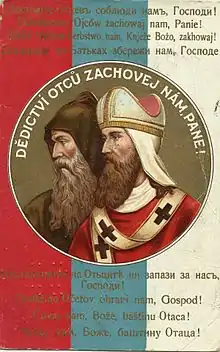Matica
A Matica or Matice or Matitsa is a Slavic concept of a foundation which promotes national culture and gained prominence during the 19th-century romantic nationalism.[1]
In this context, the word matica is translated as queen bee or queen ant.
The matica structure has been particularly used among the West Slavic peoples and South Slavic peoples:
- Matica srpska, formed in the Austrian Empire in 1826
- Matice česká, formed in the Austrian Empire in 1831
- Matice moravská, formed in the Austrian Empire in 1849
- Matice slezská, formed in Austria-Hungary in 1877
- Matica hrvatska, formed in the Austrian Empire in 1842
- Maćica Serbska, formed in Kingdom of Saxony in 1847
- Matytsia Halytsko-Ruska, formed in the Austrian Empire in 1848
- Matica slovenská, formed in the Austrian Empire in 1863
- Slovenska matica, formed in the Austrian Empire in 1864
- Macierz Polska, formed in Austria-Hungary in 1882
- Balgarska matitsa, formed in the Ottoman Empire in 1909
- Matica crnogorska, formed in Serbia and Montenegro in 1993
The term has additionally been used to refer to:
- Matica hrvatskih sindikata, Association of Croatian Public Sector Unions
- The magazine Matica, published by Matica crnogorska
References
- Marcel Cornis-Pope; John Neubauer (2004). History of the Literary Cultures of East-Central Europe: Junctures and Disjunctures in the 19th and 20th Centuries. Vol. 3. John Benjamins Publishing. pp. 41–43. ISBN 978-90-272-3455-1. Retrieved 2013-02-11.
This article is issued from Wikipedia. The text is licensed under Creative Commons - Attribution - Sharealike. Additional terms may apply for the media files.
